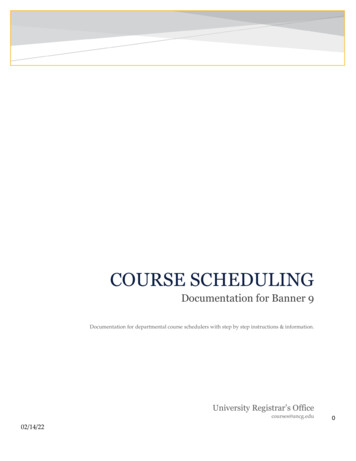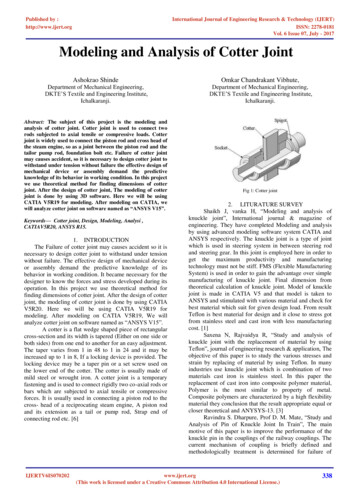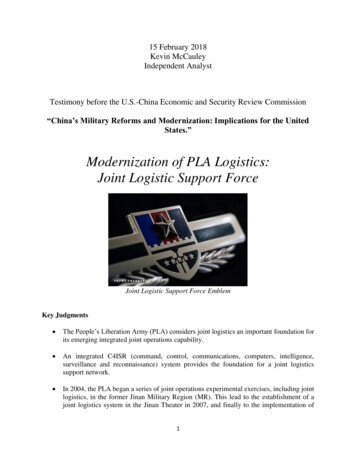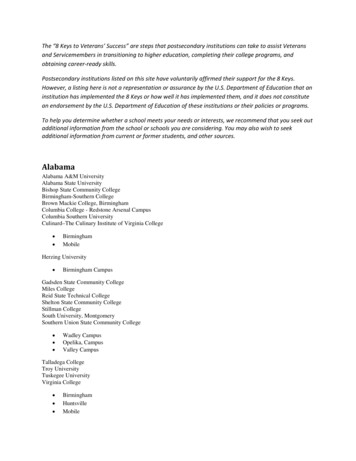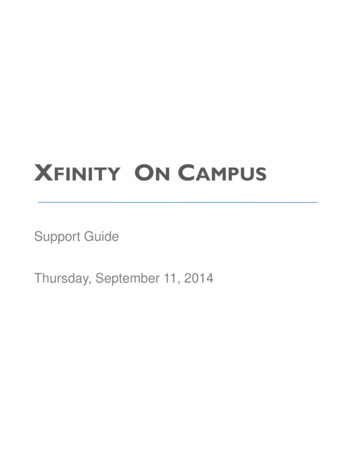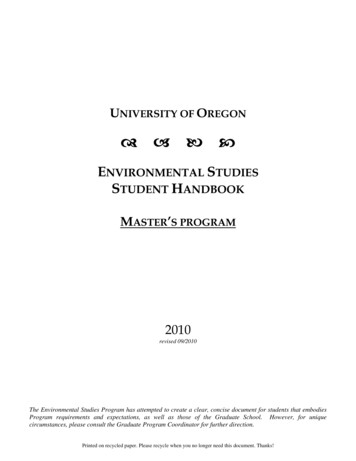
Transcription
UNIVERSITY OF OREGON ENVIRONMENTAL STUDIESSTUDENT HANDBOOKMASTER’S PROGRAM2010revised 09/2010The Environmental Studies Program has attempted to create a clear, concise document for students that embodiesProgram requirements and expectations, as well as those of the Graduate School. However, for uniquecircumstances, please consult the Graduate Program Coordinator for further direction.Printed on recycled paper. Please recycle when you no longer need this document. Thanks!
2NAMES, ADDRESSES, and MISCELLANEOUS PROGRAMINFORMATIONMailing address:Environmental Studies Program Office5223 University of OregonEugene, OR 97403-5223Program Director, Alan DickmanDirector of Graduate Admissions, TBAELP Coordinator/ENVS Undergrad Advisor, Katie LynchELP Coordinator/ESCI Undergrad Advisor, Peg BoulayOffice Manager, RaDonna AymongGraduate Program Coordinator, Gayla WardWellUndergraduate Coordinator, Alissa ManskeENVS Office FaxMaster’s Students’ OfficePhD Students’ OfficeContact info:Office location: 144 Columbia HallPhone: 541/346-5000E-mail: ecostudy@uoregon.eduWebsite: gon.edulocated in 144 Columbia Hall241 Columbia Hall240 Columbia HallElectronic Lists:econews@lists.uoregon.eduEconews is a listserv for those interested in receiving and posting action alerts, news, off-campus info, politicalupdates, etc. To subscribe, send subscribe econews your email end to majordomo@lists.uoregon.edu esgrads@lists.uoregon.eduAll ENVS grad students are subscribed to this listserv. Graduate students receive and may post announcementsconcerning only academic and program-related affairs. gesso@lists.uoregon.eduGESSO is the Graduate Environmental Studies Student Organization. All ENVS grad students are subscribedto this listserv. This list is managed by the students for the students, and is appropriate for any non-academicannouncements or invitations. The current list manager is Kevin Belanger (belanger@uoregon.edu) Publication: The Ecotone: The Journal of Environmental Studies, University of Oregon.Editors: Amanda Peacher, Kevin Belanger, Erica Elliott, Kevin Horan, Kory Northrop, Sara Nienaber, Shannan Stollhttp://envs.uoregon.edu/downloads/Ecotones Journal%20Information 1 18 07.pdfEcotone: a transition zone between two adjacent ecological communities, such as forest and grassland. It has some of thecharacteristics of each bordering community and often contains species not found in the overlapping communities. Anecotone may exist along a broad belt or in a small pocket, such as a forest clearing, where two local communities blendtogether. The influence of the two bordering communities on each other is known as the edge effect. An ecotonal areaoften has a higher density of organisms and a greater number of species than are found in either flanking community.For questions, comments, contributions, or mailing list information, contact espress@ uoregon.eduRegistration:DuckWeb: class registration, update addresses, check account status online, requires ID and PAC numbershttp://duckweb.uoregon.edu/ Let the Graduate Program Coordinator know if information is missing from this handbook that you think ought to be included.Whether it's something you've picked up during your time here, or a question you have that you don't see being addressed,your feedback will help turn this handbook into something useful for YOU C:\Documents and Settings\gaylaw\Desktop\MastersHandbook2010.doc
3PROGRAM REQUIREMENTS for the MASTER’S DEGREE . . . . . . . . . . . 4 Basic program content Description of Program Content Thesis or Project? Satisfactory Academic Progress Toward the Degree Failure to Make Satisfactory Academic ProgressACADEMIC ADVISING . . . . . . . . . . . . . . . . . . . . . . . . . . . . . . . . . . . . . . . . . . 8 Student Academic Planning Academic Advisors Concurrent DegreesGRADUATE SCHOOL INFORMATION . . . . . . . . . . . . . . . . . . . . . . . . . . . . 10 M.A. or M.S.? Grades, P/NP, Incompletes Transferring Course Work Leaves of Absence Research Clearance (Human Subjects Compliance)REGISTERING FOR CLASSES . . . . . . . . . . . . . . . . . . . . . . . . . . . . . . . . . . . . 12 Pre-Authorization (Instructor and Departmental) School of Law Classes Joint-Campus Agreement and Registration Course Registration Requirements and Limits Summer Session RegistrationFINANCIAL SUPPORT . . . . . . . . . . . . . . . . . . . . . . . . . . . . . . . . . . . . . . . . . . . 14 Office of Student Financial Aid Graduate Teaching Fellowship (GTF) Teaching an ENVS 411 course Summer Sandwich Tuition Waiver Barker Research SupportO N T E N T SINTRODUCTION and PROGRAM HISTORY . . . . . . . . . . . . . . . . . . . . . . . 4DEGREE APPLICATION POLICIES & PROCEDURES . . . . . . . . . . . . . . 17 Minimum Institutional Requirements Thesis Terminal Project GraduatingAPPENDIX A—GUIDANCE DOCUMENTS*:A-1: Guidance for Faculty AdvisorsA-2: Course Plan GuidelinesA-3: Guidance for Concurrent DegreesA-4: GTF – 411 Scheduling InformationA-5: GTF – 411 Field Trip InformationA-6: 241 Columbia / Resource Center InformationAPPENDIX B—FORMS*:B-1: First-Year Course PlanB-2: Approved Course PlanB-3: Concurrent Degree Course PlanB-4: Acceptance of Responsibility for Office Access*these require the Adobe Acrobat ReaderC:\Documents and Settings\gaylaw\Desktop\MastersHandbook2010.doc
4INTRODUCTION and PROGRAM HISTORYIn1983, under the directorship of the late John Baldwin, the first three students were admitted to theinterdisciplinary master’s degree program in Environmental Studies. In the late 1980's the program inaugurated anundergraduate minor, and the undergraduate major in Environmental Studies was launched in fall 1995. A postmaster’s Interdisciplinary Doctoral Program in Environmental Sciences, Studies, & Policy (ESSP) was approved bythe Oregon University System (OUS) in November of 1997. The first doctoral candidate entered the program infall 1998. The undergraduate major in Environmental Science began in fall 1999.Master’s students may earn either an M.S. or an M.A. degree in Environmental Studies. The individualized natureand flexibility of the program provide students with an opportunity to integrate different perspectives and developcreative approaches to their study of environmental topics.PROGRAM REQUIREMENTS for the MASTER’S DEGREE Basic Program ContentThe program has five major components:1.ENVS 631, 632, and 633 CORE SEQUENCE (9 credits total)One 4-credit, one 2-credit, and one 3-credit course during the first year.2.CONCENTRATION AREA COURSEWORK (minimum of 12 credits per area)Two areas, to be designed by the student with the approval of advisor. Each area focuses on a specificsubject/discipline or a theme.3.ELECTIVES (12 credits)Students choose at least 12 credits of electives. Students may take more elective credits, but only 12 willapply to the degree. An approved Internship (ENVS 604) may be substituted for 4 of these credits.4.ENVS 503, THESIS or ENVS 609, TERMINAL PROJECT (12 credits)Students begin taking these credits in their second year, after they have completed a significant portion oftheir coursework. The selection of a Committee Chair, and the decision whether to complete a THESIS orPROJECT need to be finalized before approval to register will be granted.5.ORAL THESIS/PROJECT DEFENSEA public defense of the thesis or presentation of the project is required.The Environmental Studies Master’s Program requires the completion of 57 graduate-level credits in theappropriate areas designated above.See Minimum Institutional Requirements, under the DEGREEAPPLICATION POLICIES AND PROCEDURES section, for further degree completion information.C:\Documents and Settings\gaylaw\Desktop\MastersHandbook2010.doc
5 Description of Program Content1. The ENVS core sequence is required of all first-year students. This core sequence is designed to introducestudents to the diversity of environmental scholarship on campus, to take them through the initial stages ofdeveloping ideas for their thesis or terminal project, and to introduce them to some research methods.2. Concentration Area course work provides the opportunity for depth in two areas. A minimum of 12 credits(usually three 4-credit courses) is required in each of two areas. The areas are subject to faculty approval. Theprogram director has discretion to waive credits or approve course substitutions.PLEASE NOTE:Lower division courses (300- or 400-level courses) do not count toward your graduate degree. However, somestudents may find it necessary to gain additional background in an area that is integral to their course of study.Students enrolled for undergraduate credit may complete graduate-level Reading credits and additional work,arranged with the instructor, to supplement the undergraduate work. Undergraduate courses may not be listed inconcentration areas; associated reading credits may apply to concentration areas if approved by the programdirector and the student’s advisor. Students should limit their enrollment in undergraduate classes.3. Electives Students choose at least 12 credits of electives that relate to their degree. Students may take moreelective credits, but only 12 will apply to the degree. Internships are not required, but if you choose to do one, youmay substitute it for 4 of these credits. Questions about internship requirements and opportunities should beaddressed to your advisor. Unless the student is working with another faculty member, the advisor is the instructorof record, and the grader, for internship credits.4. Thesis or Terminal Project credits are taken after the first year. Students may complete a formal master’s thesis,following Graduate School guidelines for the presentation of results, or they may instead complete a terminalproject. The latter offers greater flexibility in format and presentation. Both theses and terminal projects requireenrollment for a minimum of 12 hours of appropriate graduate credit (there is no maximum limit on the number ofterminal project or thesis hours that may be taken, but only 12 credits will count toward the degree). A publicdefense/presentation of the thesis/project is required. See the following Thesis or Project? subsection for furtherdiscussion. See page 18 for oral defense policies and procedures. Thesis or Project?Allstudents must complete a thesis or terminal project. The project or the thesis must integrate the twoconcentration areas. The student’s Advisory Committee oversees all thesis or project work. The committee iscomposed of at least two faculty members. The advisor designated as Chair must hold the rank of Assistant,Associate, or Full Professor. The second committee member must hold the rank of Assistant, Associate, or FullProfessor, or be a career non-tenure-track faculty (NTTF) member in ENVS with rank of instructor or seniorinstructor. One member (not necessarily the chair) must be from the ENVS core faculty. At least two universitydepartments, including ENVS, must be represented. You will choose one advisor to serve as the thesis or projectchair; that person will be responsible for grading all of your thesis/project credit hours. Students may include other,optional members who need not be part of the student’s regular Advisory Committee. However, committeemembers other than NTTF members in ENVS who do not hold an assistant professor position or higher at theUniversity of Oregon are not considered “official”.Although both options require a minimum of 12 credit hours of work, the thesis and terminal project aresignificantly different in both content and format. A thesis is an extended paper presenting independent andoriginal research which makes a contribution to the current body of knowledge in the field. The author mayconduct an original investigation or develop an original interpretation of existing research and/or literature. Athesis adheres to a strict format, generally including five basic chapters or divisions: an introduction of the problem,a review of the literature in the field, an explanation of the materials and methods used in solving the problem, adiscussion of results found from review of the methodology, and a conclusion. A full bibliography is included.Theses must be formatted to conform to Graduate School specifications as stated in the UO Style and eonlineathttp://gradschool.uoregon.edu/?page thesisDissertationResources or for a fee at the UO Bookstore).C:\Documents and Settings\gaylaw\Desktop\MastersHandbook2010.doc
6A terminal project is a presentation embodying the knowledge and skills acquired in studies for the degree. Unlikea thesis, a terminal project has no set format. Subject to approval by the candidate’s Advising Committee, theproject may be in the form of a written, oral, or visual presentation. Students should discuss the possibilities withtheir advisors. Projects completed by ENVS students have included a screenplay, various environmental curricula,a guide to environmental resource groups, and an ecological encyclopedia. Regardless of the project’s format,submission of a substantial written document is required as evidence of successfully completing the project.The decision to do a thesis versus a terminal project depends on several factors. The thesis may be preferable forstudents planning to continue their higher education or planning to remain in the academic arena. It is alsopreferable if the advisors or the student want the research to be more widely available, since the thesis is presentedto the University library and becomes available to scholars pursuing similar research. The thesis is noted on thestudent’s transcript and is thus acknowledged as a publication.For students whose program has been planned with a specific job or job field in mind, a terminal project can serveas the opportunity to prepare a document or handbook that will be used in that field. For example, one student whoplanned to work as a coordinator for senior citizen recreational activities prepared an extensive handbook of seniorcamp activities as a terminal project. The flexibility in format and content for the project allows a student toprepare something that may be more practical in nature than a thesis.Students must decide whether they will complete a thesis or a terminal project BEFORE registering forthesis or project credit hours. By the end of the first year, each student must consult with his/her advisor to makea decision on the thesis or project topic. When the student and the participating advisor have reached an agreement,the student will prepare a written proposal, which describes the topic and scope of the thesis or project. Youradvisor will then sign the proposal to indicate his or her approval. Obtaining this initial written agreement helpsprevent confusion and/or disagreement later on as to what constitutes the completed product. A copy of the signedproposal must be submitted to the Graduate Program Coordinator by the end of spring term, first year.Thesis and project credits both require instructor and departmental permission to register. When the GraduateProgram Coordinator receives your approved written proposal, you will be pre-authorized to register for theappropriate (thesis or project) credits. You may then register for the credits via DuckWeb.Students intending to use human subjects (interviews, surveys, etc.) or live animals (experiments) require advanceapproval. Please see Research Clearance (Human Subjects Compliance) under the GRADUATE SCHOOLINFORMATION section. Satisfactory Academic Progress Toward the DegreeEachstudent is responsible for meeting Graduate School requirements (see the Minimum InstitutionalRequirements subsection) and ensuring that necessary committees have been appointed and proper forms havebeen filed on time. Environmental Studies requires the following be completed according to schedule in order todemonstrate satisfactory progress.First YearBy the middle (6th week) of spring term, students are expected to: Submit a First Year Course Plan with a preliminary Advisory Committee listBy the end of Spring term, students are expected to have completed: Required ENVS core sequence (9 credits) Submission of a written thesis/project proposal signed by the committee chair (advisor) At least 30 hours of graduate course work with a minimum GPA of 3.0Second YearC:\Documents and Settings\gaylaw\Desktop\MastersHandbook2010.doc
7By the end of Fall term, students are expected to: Submit an Approved Course Plan with Advisory Committee members’ signaturesBy the end of Spring term students are expected to complete, or be progressing satisfactorily towardcompleting: All course work with a minimum GPA of 3.0 Thesis or terminal project At no time should a student have more than 3 incompletes, other than thesis or terminal project. Failure to Make Satisfactory Academic ProgressThe Program Director will inform graduate students who are not making satisfactory progress of that fact.Thestudent will prepare a signed statement of explanation for the director, who will then judge the merits of thestudent's statement. If the statement does not adequately explain the reasons for the lack of satisfactory progress,both the director's and student's statements will be placed in the student's file in the program office. Once theprogress is again satisfactory, the statements will be removed.If the statement satisfies the director that the student is, indeed, making satisfactory progress, only a statementconcerning the circumstances for apparent lack of satisfactory progress will be included in the student's record. Thatstatement will be removed when it is no longer needed to explain the lack of satisfactory progress toward a degree.C:\Documents and Settings\gaylaw\Desktop\MastersHandbook2010.doc
8ACADEMIC ADVISING Student Academic PlanningThroughout their graduate programs, students work with academic advisors. All students are assigned an interimfaculty advisor before they start the program. Each student is required to select an Advisory Committee, subject toapproval by the Program Director, which will serve to oversee both the course plan and the thesis or terminalproject. The Advisory Committee must be comprised of a minimum of two UO faculty members of assistantprofessor rank or higher, each from a different department. One member (not necessarily the chair) must be fromthe ENVS core faculty. Students may include a third committee member. Members who do not hold an AssistantProfessor position or higher at the University of Oregon are not considered “official” committee members, althoughthey may be utilized in addition to the two official committee members. Career non-tenure-track faculty (NTTF)members in ENVS with the rank of instructor or senior instructor may fulfill the role of the second committeemember, but may not serve as Chair.Because each student's program is largely self-initiated, it is critical that students give considerable thought to theiracademic plans, and schedule ample time in their first year to identify Advisory Committee members. Students areurged to consult with their interim advisor and a range of faculty as well as their student peers concerning coursework and other study options.By the middle (6th week) of spring quarter of their first year, all students must submit a First-Year Course Plan,which identifies concentration areas and a preliminary Advisory Committee. This document will be submitted tothe Graduate Program Coordinator, who will then submit it to the Graduate Affairs Committee of core faculty forapproval. The First-Year Course Plan is available on the Program web page and in this handbook as appendix B-1.By the end of spring quarter of their first year, students will submit a written thesis/project proposal, signed bytheir chair, to the Graduate Program Coordinator. A year-end review by faculty will provide feedback andrecommendations on students’ course plans and preliminary committee lists.By the beginning of their second year, students will have their course plan and Advisory Committee confirmed.During fall term, students will submit an Approved Course Plan with their permanent Advisory Committeemembers’ signatures.Students should periodically assess the course plan to ensure their work is meeting their academic and professionalgoals and aspirations. Changes can be made with the approval of the Advisory Committee if the amendment doesnot change more than 6 credits in an area, 12 credits overall.It is each student’s responsibility to keep his or her advisors informed about matters concerning the student’sacademic progress. Advisors need to be informed about issues that may interfere with satisfactory progress, such asfinances, health problems, etc., so they can act effectively as advocates for advisees should it be necessary. Theamount of time spent with a faculty advisor is left to the student’s discretion. The student is expected to takeinitiative in arranging meeting times as required. Academic AdvisorsStudents will select an advisory committee that reflects their course of study and areas of interest. The AdvisoryCommittee: must have at least two UO faculty members of Assistant Professor rank or higher (career non-tenuretrack faculty (NTTF) members in ENVS with the rank of instructor or senior instructor may serve as one ofthese members) must be comprised of faculty representing at least two UO departments must have at least one member from the ENVS core faculty (does not have to be the chair) must have one advisor designated as the chair, who will grade Thesis/Project credits may allow community members to participate as appropriate, in addition to the minimum of two UOfaculty will require the student to defend/present the Thesis/Project during the final termC:\Documents and Settings\gaylaw\Desktop\MastersHandbook2010.doc
9 oversees all Thesis/Project workIn addition, the informational sheets titled Guidance for Faculty Advisors and Course Plan Guidelines, includedin Appendix A as items A-1 and A-2, respectively, will be helpful in answering any questions you or your potentialadvisors may have about the course plan or Program. Concurrent DegreesStudents may simultaneously work on two master's degrees.To do this, it is first necessary to apply separately,and be admitted to, the two different programs.If the other major “matches” one of the student’s concentration areas, the student may choose to declareEnvironmental Studies as the second concurrent degree. In this situation, the minimum required credits to graduatefrom ENVS drops from 57 to 45 (assuming only one thesis is done; see following paragraph).If ENVS is declared the second degree, the student is required to meet the thesis/project requirement in the firstdegree, if not meeting it in the second. An advisor from the Environmental Studies program will serve on her/histhesis committee and ensure the thesis is appropriate to ENVS. We strongly recommend that the student consultboth the ENVS Graduate Program Coordinator and the Graduate School when making decisions about the thesisand outlining the Concurrent Degree form.It is recommended that students fill out the Concurrent Masters’ Degree form early in the program. The form isavailable from the Graduate School webpage. Guidance for ENVS Concurrent Degree Students and the ENVSConcurrent Degree Course Plan are included in the appendices here, as A-3 and B-3, respectively, and are alsoon the Program web page. Knowing credit and course requirements for each degree program will help prevent anysurprises when applying to graduate. Changes to the student’s program require submission of the ConcurrentDegree Revision of Program form to the Graduate School. Changes that affect the ENVS portion also requiresubmission of a new Concurrent Degree Course Plan to the Graduate Program Coordinator.Concurrent degree students, declaring ENVS as the second degree, must complete and submit the following formsto the ENVS Graduate Program Coordinator: Concurrent Masters’ Degrees Form (Graduate School form) Concurrent Degree Course Plan (ENVS form)If ENVS is declared as the first degree, the entire 57-credit program must be completed. The other degree programmay waive credits or requirements as the second degree. Check with the other degree program for details.Concurrent degree students, declaring ENVS as the first degree, must complete and submit the following forms tothe ENVS Graduate Coordinator: Concurrent Masters’ Degrees Form (Graduate School form) Approved Course Plan (ENVS form)Concurrent JD/MS students must submit a Concurrent JD/Masters’ Degrees Form. After the form is approved bythe Graduate School, the student must request a copy for the Law School in order to have the 10 semester creditswaived from the JD program. It is required that Law students finish the Master’s degree (including Thesis orProject submission) the term prior to finishing the JD to avoid complications with degree processing and Bar Exameligibility.On the Concurrent Master’s Degrees form you cannot list the same course twice (under each degree).Under the ENVS side, list only those courses that count toward your ENVS degree, so use only thecourses from your ENVS Concurrent Degree Course Plan or the ENVS Approved Course Plan.C:\Documents and Settings\gaylaw\Desktop\MastersHandbook2010.doc
10GRADUATE SCHOOL INFORMATIONThe Graduate School is the official source of information on graduate degree requirements. In addition, they housethe Graduate Funding Library, which has information on fellowships, scholarships, and research grants, andmaintain a list of GTF positions available from academic departments, administrative offices and special programs.The Graduate School is located in 125 Chapman Hall 346-5129, or http://gradschool.uoregon.edu. GraduateSchool forms are available only from the Graduate School website, and must be filled in online. M.A. or M.S.?To earn an M.S. degree, students must meet all Program and Graduate School requirements, as discussed under thesections titled PROGRAM REQUIREMENTS for the MASTER’S DEGREE and GRADUATE SCHOOLINFORMATION. All work for the degree, including transferred credits, thesis or project, and examinations, mustbe completed within the seven years prior to graduation in order to receive the degree.The M.A. degree has a language requirement. The student must show a reading knowledge of a foreign languageequivalent to satisfactory completion of the second-year college sequence either with the College LevelExamination Program (CLEP) or with adequate course work. The CLEP can be taken at the University CounselingCenter Testing Service, 346-3227. Students taking the CLEP must score in the 25th percentile or higher to qualifyfor an M.A. As with the M.S. degree, all work, including transferred credits and thesis or project, must becompleted within a seven-year period. Grades, P/NP, IncompletesTo remain in good standing with the graduate school, students must be registered for at least three graduate creditseach term. (Students with GTF appointments, see Graduate Teaching Fellowship (GTF) subsection.) All studentsmust complete a minimum of 24 graded credit hours in residence in order to graduate. Other course work maybe completed with the Pass/No Pass option, in which grades of B- or better earn a P. Under the Joint CampusAgreement (see REGISTERING FOR CLASSES section), course work taken at Oregon State University orPortland State University counts as having been taken in residence.Students are required by both the ENVS Program and the Graduate School to maintain at least a 3.0 GPA at alltimes. When calculating your GPA, consider credit hours earned as well as the grade. For example, if you have 10hours of C’s you must have 10 hours of A’s to meet the B average requirement.Students have one calendar year to convert any course incompletes into passing grades. Failure to do so will affectsatisfactory progress, as well as GTF and financial aid eligibility. If more than a year has passed and you wish toremove an incomplete, you may still be able to do so by submitting a Petition to the Graduate School form alongwith the instructor’s supplementary grade report to the Graduate School for approval (see the University of OregonCatalog). At no time should a student have more than three incompletes for course work, not including Thesis orTerminal Project credits (see next paragraph).When you take Thesis or Terminal Project credits, you will receive incompletes until the thesis or project iscompleted during your final term. These incompletes will be converted to P at the time of graduation by theGraduate School and Registrar. Unlike incompletes in regular courses, incompletes for thesis or project will notaffect your financial aid/GTF eligibility. Transferring Course WorkIt is possible to receive UO credit for up to 15 quarter credits (10 semester credits) of graduate-level course worktaken at another accredited school. Submit a Request for Transfer of Graduate Credit form, available from theGraduate School website, with official transcripts documenting the course work you desire to transfer, to theGraduate Program Coordinator. Transfer coursework is subject to approval by your advisor and the GraduateSchool. All course work, including transfer credit, must have been completed within the 7 years prior to degreeconferral. For example, if a student intends to graduate spring 2010 s/he cannot use any credits obtained beforesummer 2003.C:\Documents and Settings\gaylaw\Desktop\MastersHandbook2010.doc
11 Leaves of AbsenceStudents are allowed a maximum of three terms of academic leave during their course of study at the UO.TheRequest for On-Leave Status Form may be filled out and submitted on the
A-1: Guidance for Faculty Advisors : B-1: First-Year Course Plan . A-2: Course Plan Guidelines : B-2: Approved Course Plan . A-3: Guidance for Concurrent Degrees : B-3: Concurrent Degree Course Plan . A-4: GTF - 411 Scheduling Information : B-4: Acceptance of Responsibility for Office Access . A-5: GTF - 411 Field Trip Information


